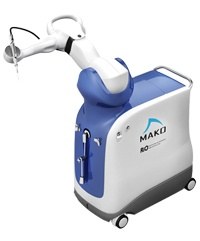MAKOPlasty®

What is Robotic Assisted Surgery
Robotic-Arm Assisted Technology is used for partial knee and total replacements.
Using a pre-op CT a specific 3-D model of your knee anatomy is constructed. This 3D model is virtually templated to determine the specific position of the implants to correct leg alignment and to balance the ligaments of the knee. This plan is then uploaded to the "robot": The robot technology enables the surgeon to perform a fully personalised surgical plan with fine control.
About the MAKOplasty® Robot
The MAKOplasty® procedure is a treatment option for patients who suffer from osteoarthritis in the medial (inner) portion of the knee or less commonly the outer lateral compartment. This technology can also be used for the patello-femoral joint and for a total knee replacement.
Using the newly developed Tactile Guidance System™, surgeons are able to perform a partial knee replacement through a 2-3 inch incision.
Only the diseased portion of your knee is removed, leaving the healthy bone and tissue surrounding it untouched.
3D modelling and templating enables the surgeon to create a plan to ensure you knee implant is:
- Sized correctly
- Positioned accurately
- Oriented with precision
Further, during the procedure the surgeon can adjust and align the implant in real time - to balance your ligaments
Benefits of MAKOplasty® Robotic Surgery
Robotic technologies have been developed with the aim of improving surgical precision, component alignment and soft-tissue balance. The expectation is that this improvement will result in better patient outcomes.
While both robotic-assisted joint replacement surgery has been met with optimism, it will take some time to obtain the necessary scientific data to be able to clearly outline its role, and it may be many years before the possible benefits of improved alignment and balance are realised. Importantly, this technology comes with added costs and a potential for increased operating time.
There AOANJRR has recorded encouraging 2-year results for robotic-assisted partial knee replacement. As robotic-assisted total knee and hip replacement has only recently been introduced, results for this technology in these scenarios are not yet known.
Comparison to non-robotic assisted partial knee replacement
A well performed Non-Robotic assisted partial knee replacement will deliver equally as good a result compared to a robotic assisted partial knee replacement.
Who are good candidates for the MAKOplasty® procedure?
Although the best treatment for each patient must be determined individually, typical MAKOplasty® patients share the following characteristics:
- Pain while standing or walking short distances
- Knee swelling
- Night pain
- Failure to respond to nonsurgical treatment such as rest, weight loss, physical therapy and non-steroidal anti-inflammatory medication
Are you a candidate for the MAKOplasty® procedure?
The first step is ta thorough assessment which includes as complete medical history including your symptoms, when they began, how they have progressed and any non-surgical treatment(s) you have tried.
Your surgeon will then perform a thorough examination of your knee, checking for such things as range of motion, ligament stability and angular deformity.
A weight-bearing X-ray will be obtained to determine the extent of damage in your knee, and to check for angular deformity.
Stages of MAKOplasty® Partial Knee Implant Surgery
The surgery has 2 stages:
Your Personalized Plan
A CT scan of your knee is used to generate a 3D virtual model of your knee. This provides us with the information we need to properly determine the damaged areas that need to be removed for the precise placement of your knee implant.
This virtual model is uploaded into the MAKOplasty® system “Robot” software and is used to create your personalized pre-operative plan.
Your Precision Surgery
In theatre your surgeon will use the Mako Robot to assist in performing your surgery which is based on your personalized pre-operative plan.
The MAKOplasty® system also allows your surgeon to make adjustments to your plan during surgery as needed to optimise the placement of the implants and to balance your ligaments.
The actual surgery will last approximately one hour and the average hospital stay is 1-3 days.
Postoperative Care
You will be permitted to walk soon after surgery, and most patients are back to normal daily activities such as driving a car within two to four weeks.
How long can an implant used in a MAKOplasty® last?
All implants have a finite life expectancy that depends on several factors including a patient’s weight, activity level, quality of bone stock and compliance with your doctor’s advice regarding appropriate activities.
However, alignment and positioning are also very important factors affecting the life expectancy of an implant. By using the MAKO Tactile Guidance System™, we aim to achieve the optimal alignment and positioning for your implant to help it last as long as possible.
In addition, because very little bone is actually removed during a partial MAKOplasty® procedure, the implant can be replaced with another procedure such as a total knee replacement in the future, if necessary.






